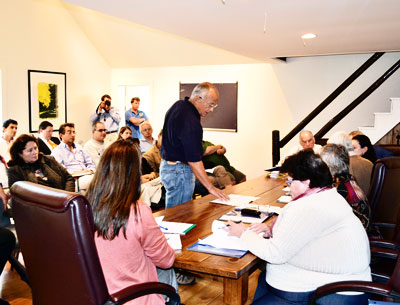Sagaponack Takes Aim At Tennis Courts

Every seat was taken at a public hearing Monday in Sagaponack Village Hall as concerned residents, real estate agents, and developers had their say on a proposed amendment to lot coverage restrictions. All of them were angry at the prospect of an increase in setback requirements for playing courts, letting the board know in no uncertain terms that tennis courts increase property value. Enzo Morabito, a real estate broker who does not live in the village, had warned residents about the amendment with a mailing to post office boxes. He called it “taking wealth from someone’s property,” saying that the inability to build a tennis court would result in “a substantial reduction in what that property is worth . . . up to a million dollars.” Almost everyone who spoke agreed. Mayor Donald Louchheim told the crowd the new law was aimed at those wanting to develop every square inch with every possible amenity. “We have seen . . . more and more intense development of each property,” he said. “Patios are gigantic now. Tennis courts take up a lot of room.” Not every lot can have a tennis court, said the mayor, “especially those under three acres,” and a compromise was necessary in order to limit the number of “reckless amenities.” He said adjacent communities had the same setbacks as proposed, some of them even more restrictive. Some in the crowd who have plans in place for tennis courts asked for either grandfathering or extensions of their permits. Armen Hovnanian, who closed on his house in April, was among them. He said he had spent time and money on plans, wetlands waivers, and approvals. Mr. Louchheim said courts that were graded and flagged before the law takes effect would have no worries. At the end of the meeting, after the room was clear, he said there would be no grandfathering. David Schoenthal bought land with every intention of building a tennis court, he said, though his permit has expired. He would not have bought the lot at all, he said, without the option to build a tennis court. Phillip Davis, another resident, said he’d once had a permit for a court but decided he didn’t want one, and now was concerned that the law would lower his property value. Michael Davis, a local builder, suggested that the proposed new setbacks were directed at noise, and said they would make little difference in that regard. He had an employee read out a long letter from an acoustical engineering and consulting company stating that “if noise reduction is a goal, this is not appropriate.” The company recommended sunken courts as an effective noise abatement. Michael Haines, a resident who had just arrived from Palm Beach to find Mr. Morabito’s card in his P.O. box, said the board should focus on real grievances. “Cutting lawns,” he said. “That is real noise. My neighbor of 20 years has a tennis court, it has never bothered me.” “I strongly request that you reconsider this without damaging property values,” said Kris Torkan, a builder from Nassau County. Absent the option to build a tennis court, he said, “absolute financial loss” was assured on a parcel he is about to close on. Mr. Louchheim suggested that the village zoning board of appeals would be able to work with hardship cases. Zachary Vichinsky, a resident and real estate broker, said the proposed amendment was “already altering decisions to purchase in this village.” “Where are the people in support of this law?” several people shouted out from their seats. Barbara Albright, a resident, was the only voice to respond. “We want more families to join the community,” she said. “Buying it to sell it is a business venture . . . I don’t want to see a bunch of tennis courts.” People also complained that the village had not told them about the proposal. The mayor noted that the village has a Web site where it posts minutes, announcements, legal notices, and draft laws. “The agendas are on there too, when we’re caught up,” he said. The amendment has been discussed for several meetings, he added, and only reporters, he said, have been in attendance. After the crowd was gone and the five trustees were talking among themselves, William Barbour observed that “not one person said anything about wanting to play tennis. It is all about money . . . They don’t want it near their house, but why should the neighbor have to look at it?” “I am in favor of leaving this just the way it is,” Mr. Barbour said. “Not having a tennis court is suffering? Walk through Sloan-Kettering Hospital if you want to see people suffering.” Joy Sieger expressed sympathy for people who had believed they could build a tennis court but could have that right “snatched away.” “There was an element of greed here,” said Mr. Louchheim. “They don’t care about the money . . . they can sink the court or tear off a wing of their house. All of these people care about their homes being devalued.” The board then directed the village attorney to redraft the portion of the law pertaining to tennis courts to exempt the proposed setbacks for courts that are sunk four feet or more, providing that site-plan review addresses noise. A resolution to adopt the new version will be presented at the next meeting, on Nov. 19. A public hearing will be held on Dec. 17. The new version of the law will be available online next week at sagaponackvillage.org/laws.
